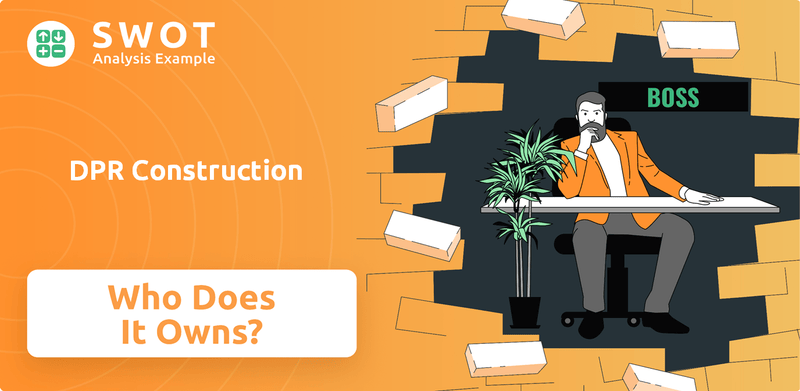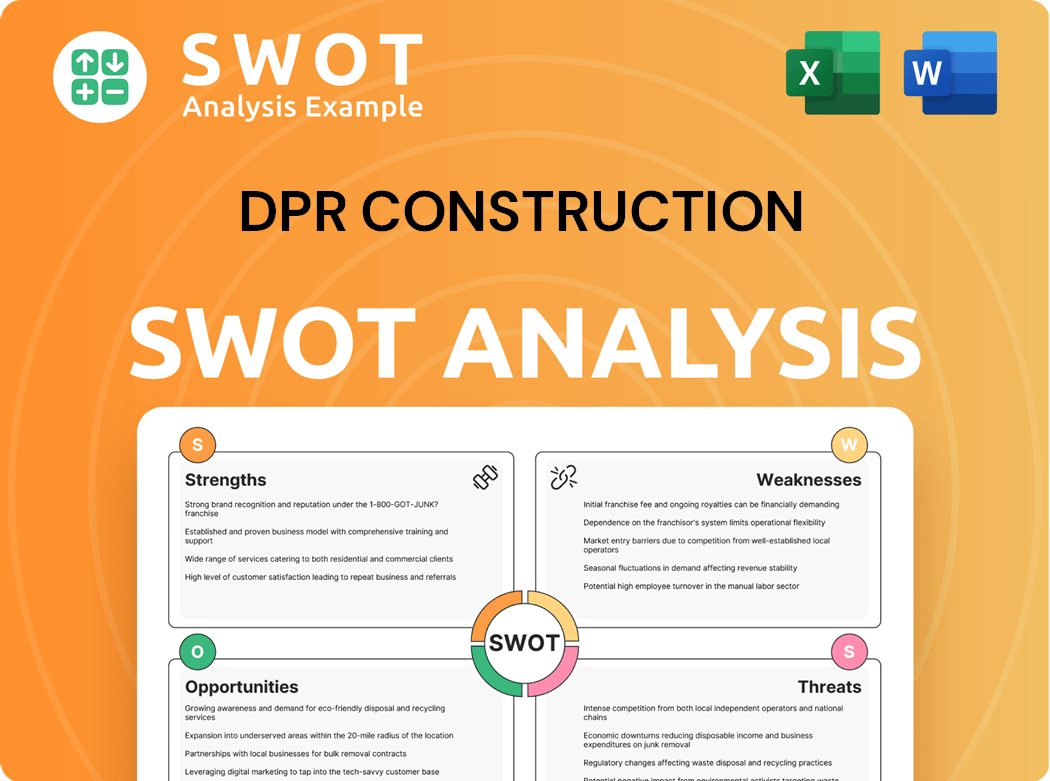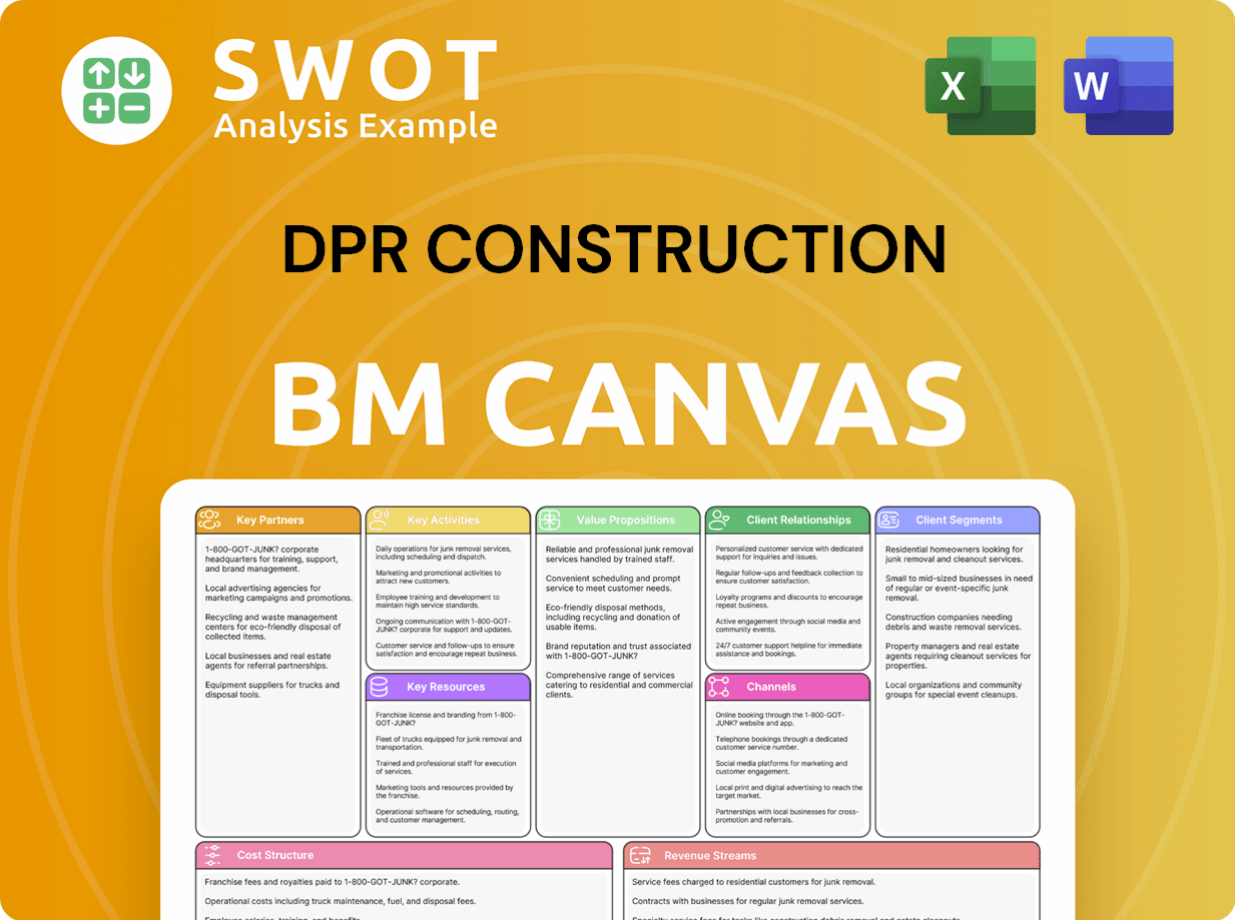DPR Construction Bundle
Who Really Calls the Shots at DPR Construction?
Understanding the ownership of a company is fundamental to grasping its strategic direction and future potential. For a construction giant like DPR Construction, knowing who owns it unveils critical insights into its operational strategies and long-term vision. This deep dive into DPR Construction SWOT Analysis will explore the company's ownership structure, providing a clear picture of its key stakeholders and their influence.

DPR Construction, a leading construction company, has a rich history and a significant presence in the industry. Examining the DPR company ownership structure offers a unique perspective on its evolution, from its founding to its current position. This analysis will uncover the key players in DPR leadership and explore how their decisions have shaped the company's trajectory, including the influence of DPR executives and the company's core values.
Who Founded DPR Construction?
The origins of DPR Construction trace back to 1990, when Doug Woods, Peter Nosler, and Ron Davidowski joined forces to establish the company. The name 'DPR' is derived from the initials of the founders' last names, symbolizing their collective commitment to the enterprise. Each founder brought a wealth of experience from the construction industry, intending to build a company centered on customer satisfaction and high-quality work.
At its inception, DPR Construction was a privately held entity. The founders held the primary ownership stakes, reflecting their shared vision and dedication to the company's early development. While specific equity splits or initial shareholding percentages are not publicly available, it's understood that the founders' contributions were central to the company's initial structure and direction.
Early ownership of DPR Construction was characterized by a close-knit structure, typical of a privately held construction company in its formative years. The company's early growth was likely self-funded or financed internally, allowing the founders to retain significant control. This approach enabled them to align the company's direction with their core principles of technical expertise and strong client relationships.
The founders of DPR Construction, Doug Woods, Peter Nosler, and Ron Davidowski, were the primary owners. The company's early focus was on building a strong foundation based on customer satisfaction and quality. The absence of external investors in the early stages allowed the founders to maintain control.
- Who owns DPR Construction? The founders held the primary ownership.
- Who founded DPR Construction? Doug Woods, Peter Nosler, and Ron Davidowski.
- DPR Construction company history: Founded in 1990, DPR's initial focus was on customer satisfaction and quality.
- DPR Construction ownership structure: Privately held, with the founders at the core.
DPR Construction SWOT Analysis
- Complete SWOT Breakdown
- Fully Customizable
- Editable in Excel & Word
- Professional Formatting
- Investor-Ready Format

How Has DPR Construction’s Ownership Changed Over Time?
As a privately held entity, the evolution of ownership at DPR Construction, or the question of 'Who owns DPR', differs significantly from publicly traded firms. The company's ownership structure primarily revolves around internal dynamics, strategic alliances, and employee ownership schemes. Unlike public companies that experience Initial Public Offerings (IPOs) and shifts in institutional shareholdings, DPR's ownership changes are less transparent. Due to its private status, specific details on investment rounds or changes in equity allocation are not publicly available. However, DPR has consistently emphasized a culture of employee ownership and partnership. This structure means that a substantial portion of the company's ownership is distributed among its employees, fostering a sense of shared responsibility and long-term commitment. The focus on internal ownership has allowed DPR to retain its core values and strategic direction, prioritizing long-term growth and employee engagement over external shareholder pressures.
The current major stakeholders at DPR Construction largely comprise the founding partners and a broad base of employee-owners. The company's leadership has consistently highlighted its employee-centric model, which includes opportunities for employees to become partners. This approach contrasts with typical private equity or venture capital firm involvement, as DPR has largely maintained its independence. This model has likely contributed to its consistent performance and strong company culture. For those interested in understanding the company's strategic focus, an analysis of the Target Market of DPR Construction provides additional insights.
| Aspect | Details | Impact on Ownership |
|---|---|---|
| Founding of DPR | Founded in 1990 by Doug Woods, Peter Nosler, and Ron Davidowski. | Initial ownership concentrated among the founders. |
| Employee Ownership Program | Implemented to distribute ownership among employees. | Gradual shift from founder-centric to employee-owned structure. |
| Strategic Partnerships | Collaborations on projects and ventures. | Potential for minor shifts in equity or influence, though details are not public. |
DPR Construction's ownership is primarily held by its founders and employees, fostering a culture of shared responsibility. The company's private status means that specific details on equity allocation are not publicly disclosed. DPR's employee-centric model and focus on internal ownership have likely contributed to its consistent performance and strong company culture.
- Employee ownership is a core aspect of DPR's structure.
- The company maintains its independence from external shareholders.
- DPR prioritizes long-term growth and employee engagement.
- Details on ownership changes are not publicly available due to its private status.
DPR Construction PESTLE Analysis
- Covers All 6 PESTLE Categories
- No Research Needed – Save Hours of Work
- Built by Experts, Trusted by Consultants
- Instant Download, Ready to Use
- 100% Editable, Fully Customizable

Who Sits on DPR Construction’s Board?
As a privately held entity, the specific composition of the board of directors for DPR Construction is not publicly disclosed in the same manner as for publicly traded companies. However, it is known that the board is primarily comprised of senior leaders within the company, including founders and key executives who have advanced through the ranks. This internal structure ensures that the board's decisions are closely aligned with the operational objectives and long-term vision of the company. Details regarding individual board members and their specific representation of major shareholders are not available to the public.
Given the company's emphasis on employee ownership and its private status, the voting structure likely empowers its partners and maintains internal control. Unlike publicly traded companies, DPR Construction does not have dual-class shares or complex arrangements to concentrate voting power. Decision-making is likely distributed among partners and senior leadership, reflecting a collaborative governance model. There have been no public reports of proxy battles or governance controversies, indicating a stable and internally managed decision-making process. This structure allows DPR to concentrate on its core business and strategic objectives without external pressures. For more insights into the company's strategic direction, consider reading about the Growth Strategy of DPR Construction.
| Aspect | Details | Status |
|---|---|---|
| Ownership | Private, Employee-Owned | Current |
| Board Composition | Senior leaders, founders, key executives | Current |
| Voting Structure | Collaborative, distributed among partners and senior leadership | Current |
DPR Construction's governance structure is designed to maintain internal control and align with its long-term strategic goals. The board is composed of internal leaders, ensuring decisions reflect the company's operational objectives. The voting structure is likely distributed among partners, fostering a collaborative environment.
- Employee ownership is a core element.
- Decision-making is internally focused.
- No public governance controversies.
- Focus on core business and strategic objectives.
DPR Construction Business Model Canvas
- Complete 9-Block Business Model Canvas
- Effortlessly Communicate Your Business Strategy
- Investor-Ready BMC Format
- 100% Editable and Customizable
- Clear and Structured Layout

What Recent Changes Have Shaped DPR Construction’s Ownership Landscape?
Over the past few years, DPR Construction has maintained its focus on employee ownership, reinforcing its commitment to internal investment and long-term stability. The company's privately held status allows it to remain agile and focused on specialized markets without the pressures of quarterly earnings or external shareholder demands. While specific financial figures on ownership percentages are not publicly disclosed, the emphasis on a partnership model, where employees have opportunities to become owners, continues to be a core aspect of its operational strategy. This approach has helped the company navigate industry trends, such as increased institutional ownership in some publicly traded construction firms, by sticking to its foundational principles.
The construction industry has seen various ownership shifts, including mergers and acquisitions, but DPR Construction has largely operated outside these trends, maintaining its private status. There have been no public statements regarding future ownership changes or plans for an initial public offering (IPO). Leadership transitions, if any, are likely managed internally within the existing partnership framework, ensuring continuity of the company's vision and operations. This strategy allows DPR to maintain its focus on its core business and strategic goals without the distractions associated with being a publicly traded entity. DPR's employee-centric model is a key differentiator in the construction company landscape.
DPR Construction's ownership structure is primarily based on an employee-ownership model. The company is privately held, which means it is not listed on any public stock exchange. Key executives and long-term employees have opportunities to become partners. This structure promotes a culture of shared responsibility and long-term investment in the company's success. The exact percentage of ownership held by individual employees is not publicly available.
The leadership of DPR Construction is typically composed of experienced executives who are also partners in the company. The company's leadership team is responsible for setting strategic direction and overseeing day-to-day operations. Information about the current CEO and other key executives can be found on the company's official website and in industry publications. The company's leadership is committed to maintaining its employee-centric culture.
As a privately held company, DPR Construction does not publicly disclose its financial information, including annual revenue or profit margins. However, industry reports and rankings often provide estimates of the company's size and financial performance. DPR Construction has consistently ranked among the top construction companies in the United States. The company's financial stability is supported by its diverse portfolio of projects and its commitment to long-term relationships with clients.
DPR Construction focuses on organic growth, strategic acquisitions, and maintaining its employee-centric ownership model. The company's strategic goals include expanding its presence in key markets and investing in innovative construction technologies. DPR Construction is committed to sustainability and is actively involved in projects that promote environmental responsibility. The company's strategic focus ensures it remains competitive in the construction industry.
DPR Construction Porter's Five Forces Analysis
- Covers All 5 Competitive Forces in Detail
- Structured for Consultants, Students, and Founders
- 100% Editable in Microsoft Word & Excel
- Instant Digital Download – Use Immediately
- Compatible with Mac & PC – Fully Unlocked

Related Blogs
- What are Mission Vision & Core Values of DPR Construction Company?
- What is Competitive Landscape of DPR Construction Company?
- What is Growth Strategy and Future Prospects of DPR Construction Company?
- How Does DPR Construction Company Work?
- What is Sales and Marketing Strategy of DPR Construction Company?
- What is Brief History of DPR Construction Company?
- What is Customer Demographics and Target Market of DPR Construction Company?
Disclaimer
All information, articles, and product details provided on this website are for general informational and educational purposes only. We do not claim any ownership over, nor do we intend to infringe upon, any trademarks, copyrights, logos, brand names, or other intellectual property mentioned or depicted on this site. Such intellectual property remains the property of its respective owners, and any references here are made solely for identification or informational purposes, without implying any affiliation, endorsement, or partnership.
We make no representations or warranties, express or implied, regarding the accuracy, completeness, or suitability of any content or products presented. Nothing on this website should be construed as legal, tax, investment, financial, medical, or other professional advice. In addition, no part of this site—including articles or product references—constitutes a solicitation, recommendation, endorsement, advertisement, or offer to buy or sell any securities, franchises, or other financial instruments, particularly in jurisdictions where such activity would be unlawful.
All content is of a general nature and may not address the specific circumstances of any individual or entity. It is not a substitute for professional advice or services. Any actions you take based on the information provided here are strictly at your own risk. You accept full responsibility for any decisions or outcomes arising from your use of this website and agree to release us from any liability in connection with your use of, or reliance upon, the content or products found herein.